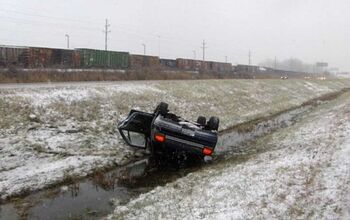The Counterintuitive Truth About Roof Crush Standards
Ever since the United States began issuing safety and emission standards, regulations have led to better cars. Emission standards forced automakers to develop electronic engine controls, creating modern cars’ power and drivability. Safety standards– seat belts, airbags, etc.– have saved countless lives. But there’s one standard that’s not only ineffective, but antithetical to its stated goal: the National Highway Traffic Safety Administration’s (NHTSA) roof crush standard.
NHTSA enacted FMVSS 216 in the mid-70’s. Before then, unbelted passengers were often ejected during a crash and killed or injured by “external factors.” It was assumed that roof strength played an insignificant role during serious accidents. As seat belts gained popularity, NHSTA created its new roof crush standard to ensure that vehicle roofs wouldn’t crush belted occupants during a rollover.
FMVSS 216 requires all light vehicles sold in the United States to withstand a force equal to 1.5 times the vehicle’s unladen weight or 5000lbs. (whichever is less), with no more than five inches intrusion. NHTSA’s technicians apply a measured force to one side of the roof’s edge, at a 25-degree angle (sideways) and a five-degree pitch angle (forwards), then measure the deflection, or failure, of the roof structure. As a result of this requirement, car makers have strengthened their vehicles’ roof structures. It would be easy to posit that the standard was– and is– an excellent piece of federal legislation. A closer examination of the evidence suggests otherwise.
The legislation’s framers knew that convertibles would never be able to meet the new roof crush standard. So they exempted them. At the time that the standard was created, convertibles were becoming increasingly unpopular. NHTSA figured that extinction would make the exemption a moot point. When convertibles made a comeback, the exemption provided valuable statistical data. Unfortunately for the rule-makers, real world experience didn’t validate the roof crush standard’s original premise. Passengers in convertibles during rollover accidents were not killed in any greater numbers than occupants of cars that met NHTSA’s roof crush standard.
This empirical data has been ignored in the face of the increased lethality of rollover accidents. Although rollover crashes constitute just three percent of all American accidents, they account for almost half of all fatalities. That’s an estimated 26,376 deaths annually. But the assumption that a weak roof collapsed and crushed the passengers is simply not supported by the data. In 74% of cases, roof intrusion was not a factor. Rollover accidents are fatal because the occupants are usually ejected, or partially ejected, during the crash.
The best way to meet NHTSA’s roof crush standard: increase the strength (and weight) of components at the top of the car, well above the center of gravity. This adds significantly to an SUV’s “top-heavy” character, and contributes greatly to their propensity to roll when subjected to large lateral forces. In other words, the requirement to make roofs stronger to withstand rollovers may well be making vehicles more likely to rollover. NHTSA’s roof crush standard is creating a vicious circle; people may be dying because of the law– not despite it.
Safety campaigners like “Protecting Health, Safety & Democracy” are lobbying the federal government to revise roof crush standards “upwards.” They want roofs to be “stronger,” so they can withstand greater impacts. Although it’s theoretically possible to find light weight materials that would withstand insult better than steel, in the real world, more stringent legislation would result in even more weight up top. And that would mean that vehicles already more prone to rollover accidents will be made even more prone to rollover accidents by the increased stringency of the rollover protection standard.
In any case, data gathered over the last three decades shows that it’s time to repeal NHTSA’s roof crush standard. The increasing trend towards taller vehicles, with a greater propensity to roll over, argues for the repeal of this standard completely, before it does even more harm. While safety campaigners argue that the revised roof crush standards don’t go far enough, NHTSA should fully and scientifically investigate the likelihood that the exact opposite is true. The rule-makers must admit the possibility that they’ve made a mistake, and find a new and more effective fix for a deadly problem.
More by Bob Elton
Latest Car Reviews
Read moreLatest Product Reviews
Read moreRecent Comments
- Dale Quelle surprise.
- 3SpeedAutomatic Nice looking, but IIRC, there was an issue with these engines where a knock would develop. That may account for the very low milage. 🚗🚗🚗
- Redapple2 Used to watch F 1 a great deal. Now? F1 Random thoughts:1 Silly rules bug me. Must use 2 types of tire. Cant refuel. Drag reduction can only be used in certain areas of the track and only if you are so close to the car in front.2 Passing is rare. Pole sitter wins a high % of the time.3 A new team can only start in F1 if they get the blessing of the overlords. Evil gm Vampire was barred. How about this. Anybody with a car that meets the construction rules can try. If your speed qualifies and you pay the entry fee. You re in. So is anybody else. 4 I tune in for Martin Brundle's grid walk. In my life, it s must see tv. But he is often bumped or cancelled. Grid walk takes place 1 out of 3 or 4 races.5 So, because of this utter bull sheet and other points, I ve migrated to IMSA and MotoGP. I might catch a summary on the youtube.
- Redapple2 I retract my comments and apologize.
- Flashindapan I always thought these look nice. I was working at a Land Rover dealership at the time the LR3 came out and we were all impressed how much better it was then the Discovery in just about every measurable way.





































Comments
Join the conversation
Are increased safety standards why nothing is made with T-tops anymore? I really, really miss those... I would hate to see the laws eliminated as I am one of the people that's alive because those standards were in place. My Geo Prizm retained most of its roof integrity when I decided to park it greasy side up about 10 years ago. Something tells me my old '72 DeVille project car I owned at the same time wouldn't have done that.
And though tough to measure - might it not be that folks in a convertible are conscious that there is little (top up) or no (top down) roof structure over their heads and thus they tone down their driving style to save their necks? When I drive vintage cars I am VERY conscious of the fact that there is very little safety equipment in my vehicle. In my VW van I am very aware that only the bumper structure (VERY stout) and the steel dash structure is going to save me in a collision. In between those two parts is a thin sheetmetal skin that may spread the collision forces - but only if something doesn't puncture it. I have seen alot of crashed VW van pics from around the web and they aren't automatic death traps but they are much less safe than most of the other vehicles on the web. The problem with the SUVs is that people have been sold them on the premise that they are safer b/c they are larger. Because I'd like to see more of them go away (the large ones), let them be sold but make it clear to the buying public exactly what happens in hard turns and rollovers. Safety campaigns = people without a healthy respect for safety and understanding of risk. I truly think that the safety campaign has had a negative result on America. I grew up crashing my bike. Lots of skinned elbows and knees. I quickly grew to respect the physics involved in riding my bike and my awareness that my bicycle was a conscious being trying to kill me. VBG! Alot of kids today have been coddled through the period of their life where my generation was going to the emergency for stitches often and therefore do not have a healthy respect for risk. Same with those same kids when they reach driving ages.